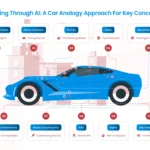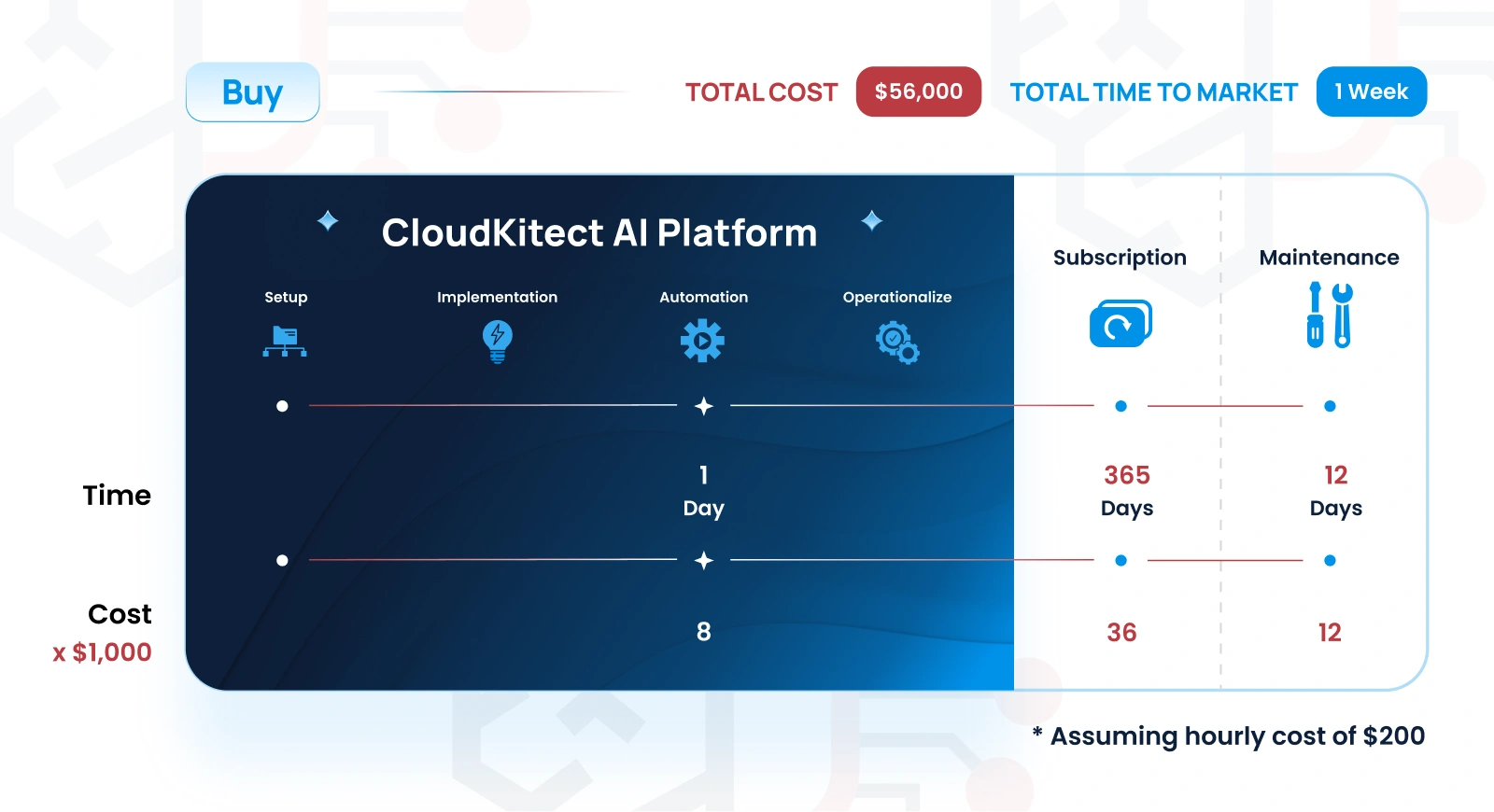
Time and Cost Analysis of Building Generative AI Solutions: Build vs. Outsource vs. Buy SaaS Products

- Blog
- Muhammad Tahir
In our earlier article here, we explored the general pros and cons of the build versus buy debate. In the execution of any project, cost and time are very important factors that can significantly influence business outcomes. In this article, we will dive deep into these two aspect of generative AI projects.
Cost encompasses not only the initial investment but also ongoing expenses related to development, deployment, and maintenance. Managing costs effectively ensures that a project stays within budget, preventing financial overruns that can jeopardize the overall health of the business.
Time, on the other hand, is a critical resource that impacts the speed at which a project is completed and brought to market. Efficient time management leads to quicker project delivery, enabling a business to capitalize on market opportunities, respond to competitive pressures, and achieve a faster return on investment. Delays can result in missed opportunities, increased costs, and a loss of competitive advantage.
Cost and time are the critical factors in deciding whether to build in-house, outsource the project to a vendor, or purchase an off-the-shelf SaaS product like CloudKitect’s GenAI Platform. Evaluating and understanding these factors before embarking on any of these paths is crucial, as it can significantly influence the success or failure of your GenAI adoption. By carefully analyzing the financial implications, you can make informed decisions that align with your strategic objectives and resources.
Building Your Own Generative AI Solution
Developing the generative AI platform in house typically involves the following process.
1. Hiring
Creating a robust generative AI solution begins with assembling a skilled team. This includes hiring data scientists, architects, software developers, security experts, and DevOps professionals. The recruitment process is very time-consuming and can take weeks or months, and is costly to involve recruiting agencies. However, it is crucial for developing a high-quality product.
2. Onboarding
Onboarding hired employees takes time as it involves integrating new team members into the company culture, processes, and systems. This process includes comprehensive training, familiarizing them with company policies, and providing the necessary tools and resources to perform their roles effectively.
3. Research and Analysis
Data scientists play a pivotal role in exploring and understanding the data. They need to conduct experiments, build models, and fine-tune algorithms to ensure the AI performs optimally. This exploration phase is crucial for developing a solution tailored to your specific needs and can take several weeks.
4. Architecting and Designing
The next step is architecting and designing the AI solution. This involves creating a scalable and efficient architecture that can handle large volumes of data and complex computations. Experienced AI architects are a scarce resource, designing a robust infrastructure can take a week or two and requires deep technical expertise with a clear understanding of the underlying technology.
5. Security and Compliance
Security and compliance are essential in any project. Security experts must evaluate the system for potential vulnerabilities and ensure it complies with industry standards and regulations. This step helps protect sensitive data and maintain trust with users.
6. Automate and Operationalize
Once the AI solution is built, it needs to be operationalized. DevOps teams automate deployment, monitor performance, and ensure the system runs smoothly. Continuous Integration and Continuous Deployment (CI/CD) pipelines are set up to facilitate rapid updates and improvements, and can take anywhere from 2 to 4 weeks depending on the complexity of the infrastructure.
Cost for Building In-House
- High initial and ongoing costs
- Long-term investment in team and infrastructure
- High control over the final product
Time for Building In-House
- Can take 6 - 9 months for end to end process
- Require ongoing research and feature enhancements
Outsourcing Your Generative AI Solution
Project outsourcing involves the following steps.
1. Vendor Selection
Outsourcing involves selecting the right vendor who can deliver on your requirements. This process can take 1-3 weeks and includes evaluating potential partners based on their expertise, track record, and alignment with your goals.
2. Contract Negotiation
After selecting a vendor, the next step is negotiating the contract. This step can take a week or two and ensures that both parties have a clear understanding of the project’s scope, timelines, deliverables, and costs. Clear agreements help prevent misunderstandings and ensure smooth collaboration.
3. Discovery Sessions
Discovery sessions are essential for understanding the business needs and technical requirements. These sessions involve detailed discussions with the vendor to align on the project’s objectives and desired outcomes and usually takes around 1-2 weeks.
4. Proof of Concept (POC) Building
Before full-scale development, a proof of concept (POC) is created to validate the feasibility of the solution. This helps identify potential challenges early and ensures the solution meets the desired performance criteria. Depending on the skillset of the vendor this step can take from 2-3 weeks.
5. Application Building
Once the POC is approved, the vendor proceeds with building the application. This phase includes developing the AI models, integrating them into the application, and ensuring they function as expected. This step can take 8-12 weeks.
6. Automation
Automation is crucial for scaling the solution. The vendor sets up automated processes for data ingestion, model training, and deployment to ensure the system can handle large volumes of data and deliver results quickly. Automating CI/CD pipelines and infrastructure provisioning can take 1-2 weeks.
7. Operationalize
The final step in outsourcing is operationalizing the solution. This involves deploying it to production, monitoring its performance, and making necessary adjustments to optimize its efficiency and accuracy. This is usually an on-going process but initially can take from 1-2 weeks.
Total Cost for Outsourcing
- Medium to high initial costs
- Potential for lower long-term costs with maintenance agreements
- Moderate control over the final product
Time for Outsourcing
- Can take 4 - 6 months for end to end platform development
- Require ongoing engagement with vendor for enhancement and feature improvements
Buying a SaaS Product for Generative AI
1. Product Selection
When buying a SaaS product, the first step is selecting the right product that fits your needs. This involves researching different solutions, reading reviews, and evaluating their features and capabilities. This selection process can take about a week.
2. Terms of Service
Understanding the terms of service is crucial when purchasing a SaaS product. This includes knowing the pricing model, usage limits, support options, and any other terms that may affect your use of the product. This process can potentially take a day, as SaaS products are offered on pre-defined terms of service.
3. Implementation
With a SaaS product, you typically have access to pre-built code that you can integrate into your systems. This reduces development time and allows you to leverage the expertise of the product’s creators. CloudKitect’s SaaS platform is offered in various programming languages ensuring minimal learning curve. Developers need to write just 5-10 lines of code to establish full CI/CD automation, set up an ingestion pipeline, configure a vector database, and create a simple API for integration with existing applications or a UI for quick deployment.
4. Operationalize
Deployment of a SaaS product is usually straightforward. Most providers offer easy integration options and detailed documentation to help you get started quickly. With CloudKitect you can set up multiple environment with fully automated CI/CD pipelines in about an hour.
5. Utilize
Once deployed, you can start using the Generative AI platform immediately. This allows you to benefit from its features without the need for extensive development or setup.
Total Cost for Buying
- Low initial costs
- Predictable ongoing subscription fees
- Limited control over customization and features
Time for Buying
- Can take 1 - 2 weeks for end to end platform
- Product vendor takes care of the new features and enhancements, you get the benefit as part of your subscription
Conclusion: Choosing the Right Path
When deciding whether to build, outsource, or buy a generative AI solution, consider the following factors:
Build
- Best for companies with the necessary resources and expertise.
- Offers maximum control and customization.
- Involves high upfront and ongoing costs.
Outsource
- Suitable for businesses that lack in-house expertise but want a tailored solution.
- Involves moderate costs with a mix of upfront and ongoing fees.
- Offers a balance of control and vendor support.
Buy
- Ideal for companies looking for a quick, cost-effective solution.
- Involves lower upfront costs but ongoing subscription fees.
- Limited customization but fast deployment and ease of use.
Each approach has its trade-offs. Evaluate your company’s specific needs, budget, and strategic goals to determine the best path forward for your generative AI initiatives. By carefully considering the costs and benefits, you can make an informed decision that aligns with your business objectives.
Still unsure? Let us assist you! Schedule a call with our AI expert today for a focused one hour engagement tailored specifically to exploring your Generative AI use cases.
Talk to Our Cloud/AI Experts
Search Blog
About us
CloudKitect revolutionizes the way technology startups adopt cloud computing by providing innovative, secure, and cost-effective turnkey solution that fast-tracks the digital transformation. CloudKitect offers Cloud Architect as a Service.




